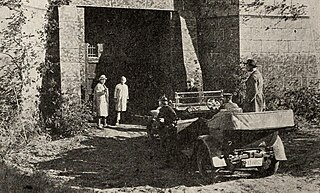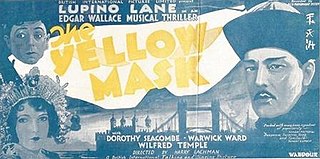Related Research Articles

Bank robbery is a type of robbery of stealing from a bank, specifically while bank employees and customers are subjected to force, violence, or a threat of violence. This refers to robbery of a bank branch or teller, as opposed to other bank-owned property, such as a train, armored car, or (historically) stagecoach. It is a federal crime in the United States.

The City of Marion is a local government area in part of the southern and western suburbs of Adelaide, South Australia. The council offices are in the suburb of Sturt.

Why Didn't They Ask Evans? is a work of detective fiction by Agatha Christie, first published in the United Kingdom by the Collins Crime Club in September 1934 and in the United States by Dodd, Mead and Company in 1935 under the title of The Boomerang Clue. The UK edition retailed at seven shillings and sixpence (7/6) and the US edition at $2.00.

The Last Sunset is a 1961 American Western film directed by Robert Aldrich and starring Rock Hudson, Kirk Douglas, and Dorothy Malone.

Lillian Russell is a 1940 American biographical film of the life of the singer and actress. The screenplay was by William Anthony McGuire. The film was directed by Irving Cummings and produced by Darryl F. Zanuck. It stars Alice Faye in the title role, Don Ameche, Henry Fonda and Edward Arnold as Diamond Jim Brady.

The Prisoner is a 1923 American silent drama film set in a fictional kingdom, directed by Jack Conway and featuring Herbert Rawlinson, Eileen Percy, June Elvidge, George Cowl and Boris Karloff. Karloff was paid $150.00 a week salary for working on this film. The screenplay was written by Edward T. Lowe Jr., based on a novel called Castle Craneycrow by George Barr McCutcheon. The film is considered to be lost.
In the Night is a 1922 British-Dutch silent crime film directed by Frank Richardson.
Hayford Hobbs was a leading British film actor of the silent era and later became a film director. He was born in London, England, in 1891. He made his first screen appearance in the 1915 film The Third Generation and appeared in his last film High Treason in 1929. The following year he directed his first film, a documentary about London.

The Loves of Robert Burns is a 1930 British historical musical film directed by Herbert Wilcox and starring Joseph Hislop, Dorothy Seacombe and Eve Gray. It depicts the life of the Scottish poet Robert Burns.
The 1983 New South Wales Open was a combined men's and women's tennis tournament played on outdoor grass courts at the White City Stadium in Sydney, Australia. The men's tournament, named ANZ Bank NSW Open, was part of the 1983 Volvo Grand Prix and held from 12 December until 18 December 1983. The women's tournament, known as the NSW Building Society Open, was part of the 1983 Virginia Slims World Championship Series and was played from 21 November through 27 November 1983. It was the 92nd edition of the tournament. Third-seeded Jo Durie won the women's singles title, the first British female player to do so since Dorothy Round in 1934.
The Flag Lieutenant is a 1926 British war film directed by Maurice Elvey and starring Henry Edwards, Lilian Oldland and Dorothy Seacombe. It is based on the play The Flag Lieutenant by W.P. Drury. Its sets were designed by the art director Andrew Mazzei. The film proved to be one of the hits of the year at the British box office.

The Manchester Man is a 1920 British silent drama film directed by Bert Wynne and starring Hayford Hobbs, Aileen Bagot and Joan Hestor. It was an adaptation of the 1876 novel The Manchester Man by Isabella Banks. It follows the lifetime of a Manchester resident Jabez Clegg during the turbulent 19th century.
Toni is a 1928 British thriller film directed by Arthur Maude and starring Jack Buchanan, Dorothy Boyd and Forrester Harvey. It was made at Elstree Studios by British International Pictures and based on a play by Dion Titheradge.

The Yellow Mask is a 1930 British musical crime film directed by Harry Lachman and starring Lupino Lane, Dorothy Seacombe and Warwick Ward. A criminal plans to rob the Crown Jewels from the Tower of London. It was based on the 1927 Edgar Wallace novel The Traitor's Gate., adapted into the play The Yellow Mask, which premiered in London in 1928.

Dorothy Seacombe was a British film actress.
The Glad Eye is a 1920 British silent comedy film directed by James Reardon and Kenelm Foss and starring James Reardon, Dorothy Minto and Hayford Hobbs. It is an adaptation of the play Le Zebre by Paul Armont and Nicolas Nancey. It was remade as a film of the same name in 1927.

At Gunpoint is a 1955 American Western film directed by Alfred L. Werker and starring Fred MacMurray, Dorothy Malone and Walter Brennan.
Victory and Peace is a 1918 British silent war film directed by Herbert Brenon and starring Matheson Lang, Marie Lohr, and James Carew. The film was produced by the National War Aims Committee that was set up in 1917 to focus on domestic propaganda during the First World War. The novelist Hall Caine was recruited for the committee by the Prime Minister David Lloyd George to write the screenplay. Lloyd George chose Caine due to his experience in the field of cinema and his "reputation as a man of letters". The film was designed to show what would happen in a German invasion. It was mostly shot in Chester with some scenes filmed at Chirk Castle. Most of the negative of the newly finished film was destroyed in a fire at the offices of the London Film Company in June 1918. It was re-filmed over four months, just as the war ended, and so never went on general release. It is a partially lost film, with only around 1,000 feet of film still surviving. Edward Elgar was to have composed the score. Originally entitled The National Film, its alternative title is The Invasion of Britain.

The Short and Tragic Life of Robert Peace is a biography by Jeff Hobbs about an intellectually brilliant young African-American man, Robert DeShaun Peace, who left Newark, New Jersey to attend Yale University, but fell back into the streets when he returned to Newark and was murdered, aged 30, "face down, knees bent", in a drug-related shooting.